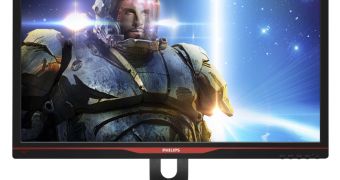NVIDIA's G-Sync might sound like a hard sell, since it needs a piece of hardware to be installed in every supporting monitor, but Philips is more than willing to go for it, as its announcement at CES 2014 has just shown.
The company has officially introduced the Philips 272G5DYEB, which doesn't outwardly look like anything special, but has the G-Sync modules installed within.
The G-Sync technology is NVIDIA's way of making sure that you don't have to choose between screen tearing and frame stuttering.
Screen tearing happens when the video feed sent by the graphics card isn't in sync with the display's refresh rate.
To eliminate tearing, you usually have to enable V-Sync, but that causes a problem of its own, namely some really annoying lag.
NVIDIA G-Sync provides the benefits without the drawbacks. The chip syncs the monitor refresh rate to the GPU render rate.
It takes a special hardware module to make it all work, as we said, and only NVIDIA Kepler-based video cards support it, but if CUDA and PhysX made it despite being proprietary technologies, G-Sync very well might too.
The other specifications of the Philips 272G5DYEB monitor are these: 16.7 million colors, a brightness of 300 cd/m2, a contrast ratio of 1000:1, and viewing angles of 170 / 160 degrees horizontal / vertical.
Needless to say, the native resolution of the LCD is of 1920 x 1080 pixels, Full HD as it were. Finally, the refresh rate is an impressive 144 Hz.
Philips is not yet selling the display, but will have it out in shops in spring, so there are only a couple of months to go (or five we suppose, if you're pessimistic). The price is (or will be) of $649 / €649 (€477 if exchange rates have any say).
Since the Consumer Electronics Show of 2014 is just starting, we expect more G-Sync LCDs to show up. Not nearly as many as UHD TVs (150 new UHD TV announcements is hard to match after all), but a few should still make it.

 14 DAY TRIAL //
14 DAY TRIAL //